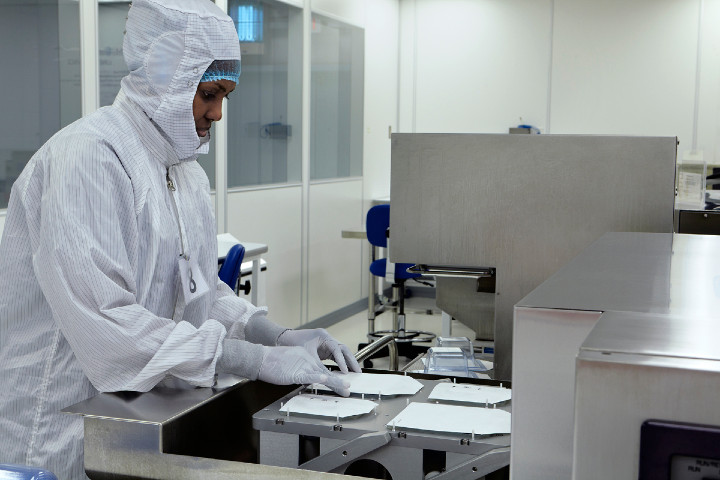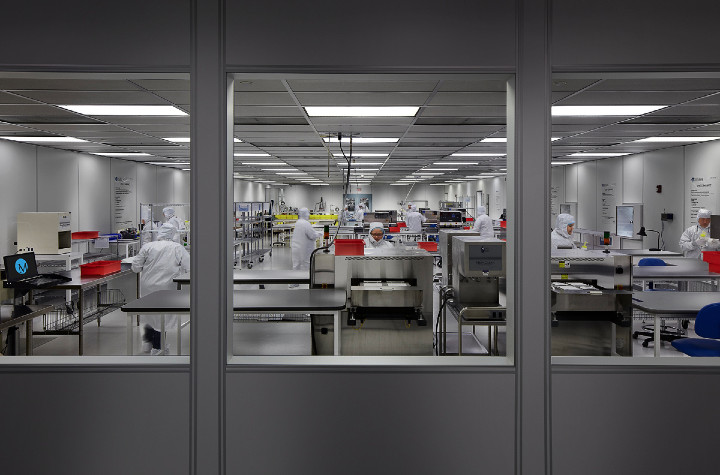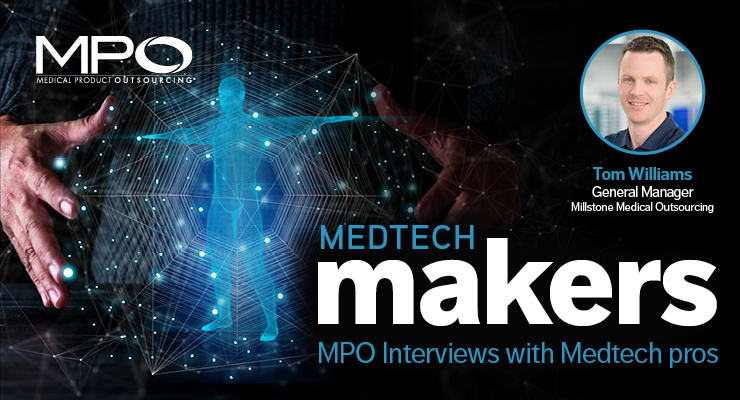By Sean Fenske, Editor-in-Chief
Managing inventory has always been a challenge for medical device manufacturers. These firms must ensure they have enough to address the rising and falling needs of customers, while also ensuring they maintain enough to address times of delay or interruption. The COVID-19 pandemic has increased the difficulty level of this task exponentially.At the same time, a firm must ensure a steady supply of materials it needs for current and future products. Working with expert outsourcing providers can ease this process, but introduces its own unique set of challenges.
Taking time to address both of these business practices and the increasing complexity of them due to the current environment of operating during a pandemic is Tom Williams, the general manager of Millstone Medical Outsourcing. Williams addresses a number of questions about managing inventory, outsourcing partners, and the supply chain.
Sean Fenske: What are the main advantages a medical device manufacturer (OEM) enjoys by outsourcing the final stages of manufacturing (e.g., packaging, warehousing, distribution, etc.)?
Tom Williams: For an OEM, the decision to outsource is highly strategic. With the right partner, outsourcing unlocks growth without adding to fixed labor costs or requiring capital investment in new facilities or infrastructure. Outsourcing reduces demand constraints on an OEM’s staff, which can enable them to focus on core competencies—like new product development and marketing—that improve profitability and grow the business.
At a more granular level, outsourcing the final stages of manufacturing can also help reduce risk and cost while increasing velocity. Packaging requires time, resources, and special expertise—all of which can flex and scale with demand when outsourced rather than on premises. The same is true for warehousing. In distribution, an outsourcing partner can help OEMs ship product and turn sets more quickly and efficiently at lower cost.

Expert packaging and stringent attention to detail can reduce risk and help OEMs focus on core capabilities and time-to-market efficiency. Image courtesy of Millstone.
Fenske: Why is it beneficial for an OEM to reduce its inventory footprint? What comprises a company’s inventory footprint?
Williams: A company’s inventory footprint consists of the capital invested in product and materials, from components to finished goods to product and sets in the field.
The more capital you have tied up in your inventory footprint, the less you have to invest in innovation—your research and development, the manufacturing of new products—and in core and legacy production. This can stifle an OEM’s growth trajectory.
More strategic management of the inventory footprint offers huge advantages. Consider, for instance, set building and loaner kit turnaround. The faster an OEM is able to get sets out into the field, the smaller its inventory footprint can be and the more access to working capital it will have.
Fenske: Given recent events with regard to shortages of medical devices due to the pandemic, do you expect OEMs will explore the idea of expanding their inventory footprint? What would your advice be to them?
Williams: These are unprecedented times, and they are prompting many business leaders across industries to look at new ways of doing things. This is true in the medical device industry, especially as OEMs analyze how to keep inventory moving more freely in the field. There are two key considerations specific to our business that are relevant to the present situation.
First, the last thing OEMs should do is lock up working capital in excess inventory. Doing so inflates the balance sheet as well as hampers investment in R&D, new product, and other innovation efforts. There are better, more strategic ways to ensure you can meet demand with supply, with more inventory visibility and by outsourcing key functions like kit building and field returns.
Second, there is some uncertainty here. In the time of COVID-19, we don’t yet know how easy it is going to be to get products in and out of hospitals. As product volumes increase over the next months, we will understand how inventory flow in and out of hospitals will affect inventory footprints.
Fenske: Many medical device OEMs have sought to decrease the number of firms within their supply chain. What has been your experience with this and what do you tell companies considering this action?
Williams: Strategic management of the supply chain has become increasingly important over the last few years in increasing profitability and reducing risk. During and after this time, it will be more important than ever to be strategic in relationships with sub-tier suppliers. OEMs must maintain open lines of communication regarding what’s going on, how suppliers should be planning resources, and what the outlook ahead appears to be.
Streamlining the supply chain can be highly beneficial in helping OEMs reduce complexity. Not all suppliers are equal, though. It’s essential to seek and engage with an expert partner with specialty industry experience; otherwise, OEMs are (knowingly or not) increasing risk in the inbound supply chain as well as the business in general.

Millstone's staff operate state-of-the-art equipment and adhere to best-in-class quality processes in a class 10,000/ISO 7-rated cleanroom. Image courtesy of Millstone.
Fenske: Again looking at recent events related to the pandemic, do you expect this practice to continue or will some companies reverse course and seek to expand their supplier base so as to address potential shortages during a crisis?
Williams: The unfolding pandemic has highlighted supply chain vulnerabilities across industries. Certainly, OEMs will examine their product portfolio to understand where the potential for risk lies. Being strategic requires evaluating how the risk of potential supply chain disruption could affect production—and ultimately customers—should the pandemic drive suppliers to change business processes or lead to future interruption. The future still presents unknowns, and OEMs are well-advised to consider how to dual-source components and raw materials for certain suppliers—those in China, for example—and products in the inbound supply chain that may be affected as the pandemic continues to unfold.
Expanding the supplier base comes with its own risks. The number of suppliers in the inbound supply chain affects overall complexity, as it is more difficult to manage variability, quality, communication, and assembly schedules. OEMs must strike the right balance between supply chain risk and strategic sourcing management. An expert outsourcing partner offering a service like Millstone’s Tier 1 service can help OEMs better manage risk in the supply chain while reducing complexity and enabling access to more working capital.
Fenske: Another trend we’re seeing in the medical device outsourcing space is the transfer of risk from OEM to supplier. OEMs are asking their outsourcing partners to take on more risk in the manufacturing process. Have you encountered this and how are you addressing it?
Williams: Yes, this is something we have encountered. It’s important to understand all risk isn’t created equal. Contract manufacturers are accustomed to risk in the manufacturing process; risk has always been part of the relationship. What’s different now is OEMs have pushed out product design to some contract manufacturers, which can elevate risk. If an OEM is the manufacturer of record for a particular product, it’s in their best interest to ensure the risk between OEM and contract manufacturer is clearly defined and communication is transparent between the parties. In the end, if there is a quality issue, recall, or other problem, an OEM’s reputation can be at stake.
When an OEM outsources contract manufacturing, it’s absolutely essential to success there are robust processes in place to ensure quality and manage subvendors, ensuring the end product the OEM receives is what they expect and all facets of risk are minimized.
Fenske: Do you anticipate a reevaluation/reconfiguration of the OEM-supplier outsourcing relationship post-COVID? Based on conversations with your customers and/or those who have since reached out to you, in what ways might this arrangement change in the coming years?
Williams: As COVID-19 is still very much a part of our present, this is an evolving situation. During the earlier part of this year—the end of Q1 and Q2—we passed through a valley of gloom and doom. Now we are starting to see the signs of movement and growth as we pass through Q3 and Q4 and anticipate early 2021.
As I mentioned earlier, there is some uncertainty in inventory flow in and out of hospitals. We’ve also seen some lead pressure on critical items as well as field returns and repackaging services. As Q4 and early 2021 play out, we anticipate leaders in our industry will begin to look at inventory visibility differently. There will be an examination of what OEMs have in the field, where it is, how it can be captured, and how it can be positioned to meet demand and drive revenue. There is the potential for this period to foster a step into the future—a shift change in open-mindedness to a more flexible model of reverse logistics.
Fenske: Do you have any additional comments you’d like to share based on any of the topics we discussed?
Williams: This has been a challenging time, and OEMs have been pushed and stretched in managing planning, forecasting, supplier coordination, and distribution in ways they have never before encountered. Change is never easy, but it can present the impetus to look at new ways of doing things.
Outsourcing is a way to gain access to some of the best minds and most current thinking in the industry without increasing fixed costs. Even if OEMs are just at the consideration phase, a partner like Millstone can help as we all move into this new normal.
Learn more about Millstone Medical Outsourcing >>>>>














